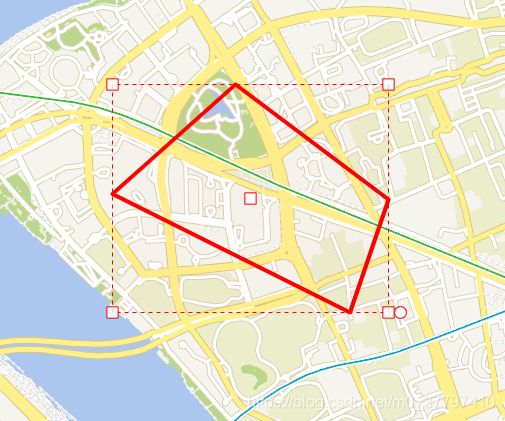openlayers拖拽、旋转、缩放、拉伸变形 (十二)
gis应用中拖动旋转和缩放是编辑中比较常见的功能,在openlayers中拖拽可以通过ol.interaction.Translate来实现,但是其他功能没有,所以要用的openlayers的一个扩展ol-ext。
1. ol-ext
ol-ext是openlayers的扩展,他主要包含控件,交互,弹出窗口等功能。类似于WEB前端的UI框架。他是一个成熟的扩展,可以让你省去很多时间,避免很多问题。
注意区分一下使用方式对应的包名:
在webpack中使用
npm install ol-ext
在web中使用
npm install openlayers-ext
ol-ext官网链接
ol-ext在线示例
注意3.1.0版本之前某些功能会需要依赖jQuery。
2. 创建地图
const tileLayer = new Tile({
source: new XYZ({
url: `http://192.168.0.98:5000/tiles/world-base/{z}/{x}/{y}.png`,
}),
})
const map = new Map({
view: new View({
center: transform([121.507291, 31.235963], 'EPSG:4326', 'EPSG:3857'),
zoom: 15,
maxZoom: 18,
minZoom: 11,
}),
layers: [tileLayer],
target: 'map'
})
this.map = map
3. 添加几何图形
const polygon = new Feature({
geometry: new Polygon([
[
transform([121.501842, 31.239204], 'EPSG:4326', 'EPSG:3857'),
transform([121.506337, 31.238305], 'EPSG:4326', 'EPSG:3857'),
transform([121.506606, 31.235846], 'EPSG:4326', 'EPSG:3857'),
transform([121.500243, 31.236103], 'EPSG:4326', 'EPSG:3857'),
]
]),
})
polygon.setStyle(new Style({
stroke: new Stroke({
width: 4,
color: [255, 0, 0, 1],
}),
}))
this.map.addLayer(new VectorLayer({
source: new VectorSource({
features: [polygon],
}),
}))
4. 添加交互
关键代码在这,new一个ExtTransform对象,再通过map对象的addInteraction方法添加进去。
ExtTransform是ol-ext/interaction/Transform。
const transform = new ExtTransform({
enableRotatedTransform: false,
hitTolerance: 2,
translate: true, // 拖拽
stretch: false, // 拉伸
scale: true, // 缩放
rotate: true, // 旋转
translateFeature: false,
noFlip: true,
// layers: [],
})
this.map.addInteraction(transform)
这里单独记一下配置中的layers,当你需要指定哪些矢量层才能编辑,那么在这里填入对应的矢量层对象就行。
layers: [ VectorLayer ]
VectorLayer是new ol/layer/Vector的对象。
5. 效果展示
6. 完整代码
<template>
<div class="map" id="map"></div>
</template>
<script>
import { Map, View, Feature } from 'ol'
import { Tile, Vector as VectorLayer } from 'ol/layer'
import { XYZ, Vector as VectorSource } from 'ol/source'
import { Style, Stroke } from 'ol/style'
import { Polygon } from 'ol/geom'
import { transform } from 'ol/proj'
import ExtTransform from 'ol-ext/interaction/Transform'
export default {
data() {
return {
map: null,
}
},
computed: {},
watch: {},
beforeCreate() {},
created() {},
beforeMount() {},
mounted() {
this.createMap()
this.createPolygon()
this.onEdit()
},
activated() {},
deactivated() {},
beforeUpdate() {},
updated() {},
beforeDestroy() {},
methods: {
createMap() {
const tileLayer = new Tile({
source: new XYZ({
url: `http://192.168.0.98:5000/tiles/world-base/{z}/{x}/{y}.png`,
}),
})
const map = new Map({
view: new View({
center: transform([121.507291, 31.235963], 'EPSG:4326', 'EPSG:3857'),
zoom: 15,
maxZoom: 18,
minZoom: 11,
}),
layers: [tileLayer],
target: 'map'
})
this.map = map
},
createPolygon() {
const polygon = new Feature({
geometry: new Polygon([
[
transform([121.501842, 31.239204], 'EPSG:4326', 'EPSG:3857'),
transform([121.506337, 31.238305], 'EPSG:4326', 'EPSG:3857'),
transform([121.506606, 31.235846], 'EPSG:4326', 'EPSG:3857'),
transform([121.500243, 31.236103], 'EPSG:4326', 'EPSG:3857'),
]
]),
})
polygon.setStyle(new Style({
stroke: new Stroke({
width: 4,
color: [255, 0, 0, 1],
}),
}))
this.map.addLayer(new VectorLayer({
source: new VectorSource({
features: [polygon],
}),
}))
},
onEdit() {
const transform = new ExtTransform({
enableRotatedTransform: false,
hitTolerance: 2,
translate: true, // 拖拽
stretch: false, // 拉伸
scale: true, // 缩放
rotate: true, // 旋转
translateFeature: false,
noFlip: true,
// layers: [],
})
this.map.addInteraction(transform)
}
}
}
</script>
<style lang="scss" scoped>
.map{ width: 100%; height: 100vh; }
</style>
7. 补充
通过上面例子的思路,除了几何图形的编辑,同样图片,canvas,svg一样也可以,等有空再来补充demo。
